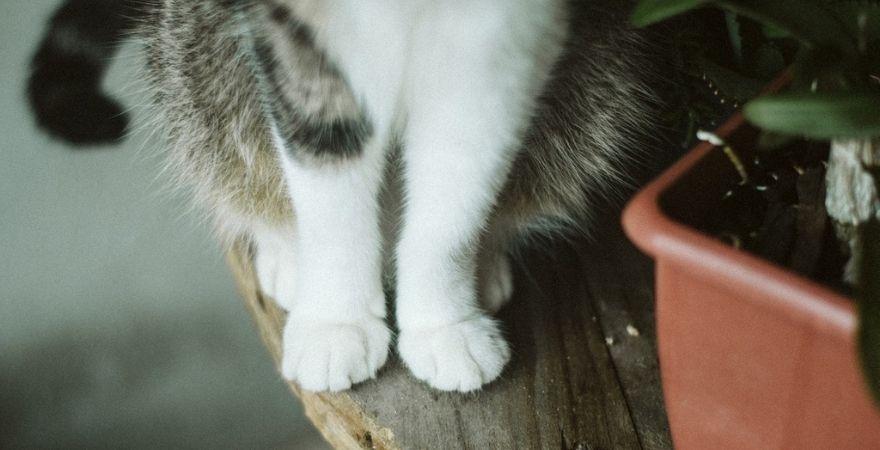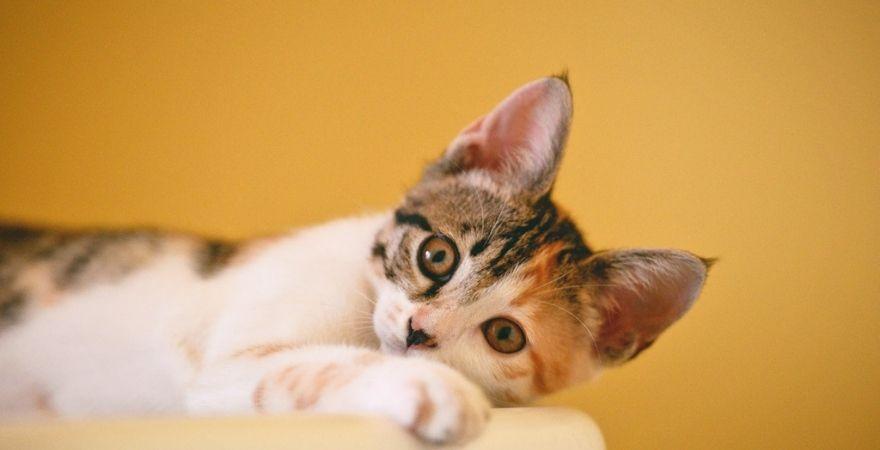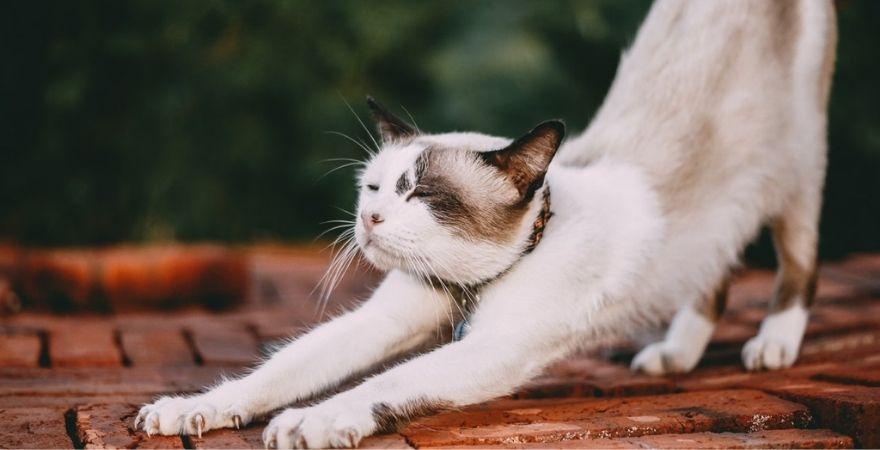Wait — what’s that smell?
AGAIN?!
It’s the third time (today) you’re mopping up a stinky puddle, wondering why kitty seems to go everywhere but inside the litter box.
It’s almost like they can’t make it in time.
What’s going on?

Feline Lower Urinary Tract Disease or a cat UTI, is when the bladder gets infected by bacteria through the urethra. If not diagnosed and treated in time, a UTI can block the urethra completely, causing kidney failure or a ruptured bladder.
Once a UTI gets diagnosed, treatment can include giving kitty prescribed antibiotics and making changes in their diet. Middle-age and overweight cats that don’t drink enough water are most likely to contract a cat urinary tract infection.
What is a Cat UTI?
A feline urinary tract infection happens when bacteria gets into the bladder through the urethra. The bacteria makes the urethra swollen, making bathroom trips painful for kitty. Diagnosing a cat UTI is tricky, since many symptoms and the infection can be the cause or result of other health problems. If testing can't confirm a UTI, or another disease (urinary stones, or a urethral obstruction), the term idiopathic cystitis gets used.
How do Cats Get a UTI?
A lack of water, unclean environment, age, and stress are the biggest causes of urinary tract infections in cats.
Other triggers include:
- Stones, crystals, or debris buildup in the bladder or urethra
- Urethral plug (buildup from debris in urine)
- Inflammation or infection in the bladder
- Injury inside the urinary tract
- Spinal cord problems
- Congenital problems
- A tumor inside the urinary tract (but this is less common)
Cats are creatures of habit by nature, making them prone to stress when their routines get disrupted. Major changes like moving to a new place, introducing a new pet (or human) to the family, or small inconveniences like putting the litter box in a dark corner beside noisy appliances (the old dryer with a built-in buzz timer for example) triggers kitty’s stress — and urinary tract problems.
How do You Know Your Cat has a UTI?
Peeing outside the litter box is a major sign that kitty might have urinary tract problems, other signs include:
- Licking the genital area excessively
- Many trips to the litter box
- Squatting to pee in front of you
- Peeing outside the litter box (on plastic bags, your laundry, the tub or sink)
- Vomiting
- Lethargy
- Abnormal-smelling urine
- Lack of large clumps in the litter box
- Straining to pee
- Crying from pain while peeing
- Blood in the urine
Cats don’t show signs of being sick or in pain (an evolution trait that keeps them from looking weak in front of predators), preferring to keep to themselves more than usual or finding ways to work around the pain — meaning you’ll need to start watching kitty more closely if you notice small changes in their habits, and make an appointment to see the vet if you see any of the above signs!
Diagnosis
Since cat UTIs are hard to diagnose, your vet will most likely do a urinalysis (a microscopic analysis of kitty’s urine sample), or a physical. If the vet needs more tests, they might recommend blood work, x-rays, abdominal ultrasound, and/or a urine culture.

Treatment Options
After confirming that kitty does have a feline lower urinary tract disease, your vet might prescribe antibiotics to help clear up the infection. If medication is part of the treatment plan, make sure to follow the instructions and finish the prescription — even if kitty starts feeling better sooner than expected, the infection can return if you stop the medication early.
Increasing kitty’s water intake, moving the litter box to a quiet, well lit part of the house (and scooping more often), and keeping their stress levels down will help kitty get back to their normal bathroom routine.
UTI Cat Food
There are commercial dry foods that help with cat UTI prevention, but water helps treat and prevent cat UTIs. Cats have no problems going without water for long periods of time — and they have a hard time drinking it. A kitty fountain (cats prefer drinking from running water), wet food, or bowls of fresh water around the house helps kitty stay hydrated.
Scruffy Paws UT Wellness Chews
Made with UTI-fighting ingredients like cranberry extract, bromelain, and N-Acetyl, these chews are a delicious and stress-free way to help your furry friend recover from any urinary infection.
Most importantly, you can always read the supporting research for Scruffy Paws' products in the Scientific Backing section, and every product gets made in the USA.
Home Remedies
If kitty’s vet recommends going the organic route, look for specialized foods with the following ingredients:
- Parsley leaf — helps with eliminating waste and has antiseptic qualities
- Cranberry — prevents the UTI from sticking to the urethra wall
- Glucosamine — helps restore a compound found in the lining of the bladder wall called glycosaminoglycans (GAG).
- Chondroitin — protects the GAG from getting broken down
- Juniper Berry — antibacterial and antifungal properties help fight the infection, increases urine flow, and helps with pain relief.
- Marshmallow Root — helps increase the flow of urine
More Hydration, Less Stress, Repeat
Cat urinary tract infections make potty time painful for kitty — as well as dehydration, stress and an unclean environment.
As long as a diagnosis is made in time, a treatment and prevention plan gives kitty a chance to go to the bathroom in peace.
References




